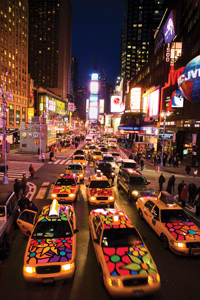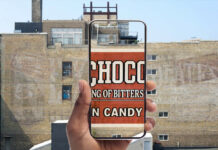Last year, residents of New York’s inner city neighborhoods saw the drab laundromats where they often gather revitalized with vibrant wraps and colorful graphics.
This summer, visitors to MacArthur Park in Los Angeles will see the destination assume new hues when hundreds of giant balls, painted with a comparable mix of flowers and forms, float on the water.
These projects (and many more) are the realization of Portraits of Hope, a vision shared by brothers Ed and Bernie Massey to use art on a grand scale to benefit children and the communities where they live.
Drawing on support from government leaders, corporate sponsors, volunteers, and the printing trade, they combine public art and civic involvement to empower and enrich young lives, especially the disabled and disadvantaged.
“We’ve worked with communities all over the country, large and small,” says Bernie, spokesman for Portraits of Hope. “These projects are really amazing collaborations and, for me personally, incredibly rewarding.
“The dynamic public visuals stand out and command attention in the best of ways, but the story behind the visual transformations is what makes Portraits of Hope, ‘Portraits of Hope.’”
Creative Therapy
The brothers started the non-profit in 1995 to develop and implement public arts projects as creative therapy for hospitalized or physically disabled children.
Since then, notable successes include wrapping airplanes, blimps, buildings, lifeguard houses, New York taxis, and NASCAR racecars. Before last summer’s laundromat transformation, Portraits of Hope wrapped the fleet of emergency vehicles serving the area around Aspen, Colorado.
To date, more than 70,000 children and 800 hospitals, school programs, social service agencies, and civic groups have contributed to Portrait of Hope’s success.
Although the scope and setting of projects vary, each shares common goals and procedures. At the core, they are developed to enrich the lives of disadvantaged children through personal achievement. Through their participation and artwork, they learn values of civic responsibility and team work.
“Without the support of (the printing) industry, none of these could happen,” notes Bernie.
His brother Ed adds, “The generous spirit of many in the industry has made all our projects possible and enabled thousands of children, many with very difficult circumstances, to beam with pride and achieve in a very big and public way.”
Digital Graphics
Large format digital printing provides the means for imparting those lessons and bringing these projects to life. Every project features the Portraits of Hope’s iconic logo flower and other graphics designed by Ed, an accomplished artist. They are first printed as black outlines on large format presses and digital media.
These graphics are then hand-painted by the children, from a pallet of fourteen colors. Since the goal is to be totally inclusive, the Massey brothers have had to develop some special paint brushes and methods so every child could contribute, regardless of disability or physical condition.
They also rely on volunteers in every community to help coordinate each project and assist in these paint sessions. “There’s so many steps, we need volunteers all the time, and almost always depend on installers who donate their time,” says Bernie.
Support takes many forms: cash contributions, outright sponsorship, materials given or sold at cost, and donations of time and services. “No one pays the full cost because we always need something donated,” says Bernie, “and we scale each project in terms of the financial support we have for it.”

Visual Transformation
These projects begin in several ways. For the most visible, large-scale initiatives, the brothers look for opportunities to transform the familiar in high-profile settings into something uniquely visual and engaging. These can be the most difficult to pull off, as they must convince civic leaders to sign off on them.
“We have to go to the local government and explain how we want to take this asset they have and transform it visually in a way that will benefit the entire community,” says Bernie. “The biggest challenges are getting government approval then lining up financial support.”
Occasionally local representatives approach the group about bringing a Portraits of Hope project to their community. Or corporate sponsors contact the Masseys about backing a project as a community outreach/public relations initiative.
That’s how the New York laundromat transformation came about. “We’d worked with Proctor and Gamble on a project involving the Santa Monica ice skating rink, and they were very happy with the experience,” recalls Bernie. “Early last year, they approached us again and asked if we could come up with something in a major city [connected with a P&G product] for another project.”
The Massey bothers submitted five proposals, including the laundromat wraps. “In the inner city, these serve as neighborhood community centers, where adults and kids spend hours at a time,” notes Bernie. “They’re taken for granted and tend to be pretty dull. We thought if we could visually transform them, we could add some positive energy.”
P&G selected its Gain brand of laundry products as official sponsor. With that go-ahead, the brothers scouted 150 laundromats in the city before selecting six for the project, four in the South Bronx, one in Washington Heights, and one in Harlem.
The project called for total wraps, including washing machines and dryers. Because of the wear and tear and heat generated in these spaces, they needed durable materials.
MACtac, a long-time supporter, donated its IMAGin® JT5529BFD Pro vinyl for washers, its JJ5999MBF for dryers, and its IMAGin® M Series™ EMR328 and EMR329 films and PermaFlex® PF6500 overlaminate film for floor graphics. Printing services were donated by Imagic of Los Angeles on its HP Scitex XL 1500 solvent inkjet printer. Distributor Laird Plastics provided logistical support to see the project through.
In New York, they required a mix of former and new volunteers. “While Ed and I were measuring one laundromat, some school kids came by and asked what we were doing,” recalls Bernie. “When we told them, they got real excited and ran and got their principal. Then their school became involved.”
Hundreds of children participants were drawn from the neighborhoods surrounding each laundromat, assisted by supporters from New York Cares and Hudson River Park. Installation services were donated by Owen Palmer and a team from 5zero4 Designs, Los Angeles.
“We always use our graphics and try to do some things different when we can,” says Bernie. “Here Ed made chandeliers and lamps out of Gain bottles and designed special graphics for laundry carts, baskets, and recycling containers.”
The transformation was so festive and welcoming that several laundromats still shone with their new colors this year, long after the planned three-month run for the project.
The Masseys are on to the next, steeped in preparations for the summer transformation of MacArthur Park Lake. They’re also formulating plans for even further into the future, which could bring the benefits of Portraits of Hope to communities and children nationwide in 2016.

Transforming Shelters
“We have this huge initiative we’ve wanted to do for a long time, beautifying animal shelters all over the country,” says Bernie.
They hope to wrap shelters in flowers, shapes, and animal designs, once again printed digitally and painted by local children. “It could be our largest campaign ever,” notes Bernie. “Many shelters are blighted, and we want to make them more inviting and get kids involved and aware of animal adoption.”
It will require ambitious support from communities and their corporate citizens. “We’re going to need a lot of help in volunteers, materials, regional printing, and installation services and will start in those areas where there’s the most interest and support,” says Bernie.
Anyone interested in helping can contact the Masseys on the group’s Web site. “The industry’s assistance to our projects—from donating materials, supplies, logistics to printing, shipping, and installation—is instrumental in making them a reality,” says Ed.
“The printing industry makes these projects happen,” says Bernie. “They’ve been very generous with their support.”
By Mike Antoniak
All photos: Portraits of Hope.











